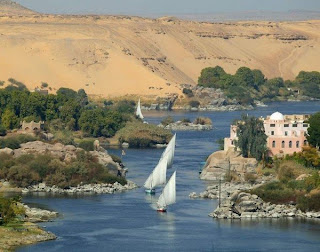Nile River Valley
The 5th century B.C. Greek historian Herodotus declared that Egypt is the “gift of the Nile.” He simply stated what all have always known to be true: without the Nile, there is no Egypt. Where the Nile overflows its banks, the land is green, and where the water’s influence stops, the desert begins. The rainfall south of Cairo averages 1 1/2 inches per year, and often there is no rain at all during the year. Apart from a few western oases, Egypt is a desert, and only 3% of the land (that which is along the Nile River) can be cultivated. 99% of the population of Egypt today lives in the Nile River Valley.
The Nile begins in the area of Urundi and flows through Uganda into Sudan. The river has two branches (White and Blue), and its total length is about 4,000 miles (6670 km). Only 900 miles (1530 km) of the river is in the modern country of Egypt. The two branches join just north of the modern city of Khartoum, Sudan.
The Nile River was a united system in Egypt. Perhaps for this reason, the ancient Egyptians did not have a name for this river. The Egyptians simply called the Nile “al-taru,” which is the Egyptian word for river. In their world, there was only one river. It is still uncertain where the ancient Greeks got the word “Nilus,” from which we get the word "Nile."



